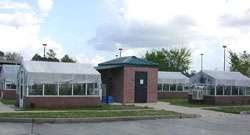|
|
Global Change Science: Climate and Land Use Change
USGS scientists researching global change develop study plans to monitor, assess, and predict how different stressors affect the release of greenhouse gases. Studies conducted at NWRC explore how increases in temperature, sea level, and atmospheric carbon dioxide affect wetland plants and how forest stands along different stages of ecological succession transform, convey, or mediate these atmospheric gases. 
Global change is broadly defined under the U.S. Global Change Research Act of 1990 (Public Law 101-606,104 Stat. 3096-3104) as “Changes in the global environment (including alterations in climate, land productivity, oceans or other water resources, atmospheric chemistry, and ecological systems) that may alter the capacity of the Earth to sustain life.” Fluctuations do not necessarily refer to human-induced changes or even to recent occurrences, but reflect long-term changes observed across the globe. The USGS undertakes scientific research, monitoring, remote sensing, modeling, synthesis, and forecasting to address the effects of climate and land use change on the Nation’s resources. The resulting research and products are provided as the scientific foundation upon which policymakers, natural resource managers, and the public make informed decisions about the management of natural resources on which they and others depend. Research
View Global Climate Change Fact SheetsReturn to Forest Ecosystem |